Baldwin: AS-16
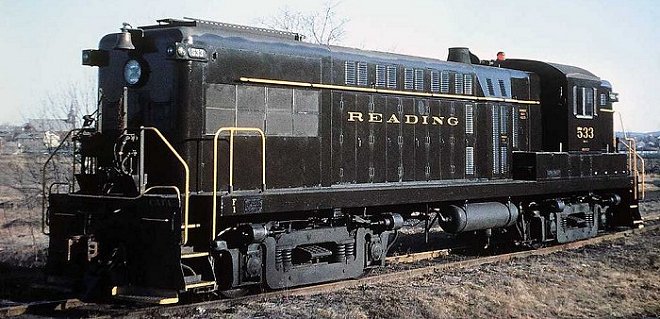
The Reading was a long-time customer of the Baldwin Locomotive Works in the steam era, as well as after the transition to diesel power; having purchased many Baldwin switching locomotives from 1939 onward. At the end of World War II, over half of the Reading's diesel switchers had rolled out of the Eddystone plant. So, when the Reading began purchasing diesel motive power for road service, it was fitting that a good portion of their initial acquisition would be Baldwin products. Beginning in July, 1951, Baldwin AS-16s began to arrive on the property in groups. By 1953, the Reading's fleet of AS-16s numbered 43 units, making the Reading the "majority owner" of this type of locomotive.
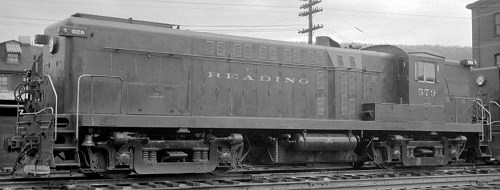 The "1951" group of the Reading's Baldwin AS-16s were classified as "RS-2" locomotives and were numbered 530 - 550. Units 560-563, classified "RS-2b," also arrived in September 1951, and were equipped with steam generators for passenger service, most commonly on the Bethlehem and Newtown branches, but also on the Main Line trains such as the King Coal. In the summer of 1952, the Reading took delivery of additional AS-16s numbered 576 through 589. These units were put into service at Erie Avenue and St. Clair, replacing N1 Mallet and I9 Consolidation steam locomotives (1951-1953 was the twilight of the steam era on the Reading). This batch of AS-16s had some notable spotting differences from their earlier counterparts. The numberboards/marker lights on the short hood were mounted at the very top of the hood. Also, the fuel tank was moved under the frame between the trucks from its normal location in the short hood to make room for dynamic brakes. Finally, screening was installed to cover the dynamic brakes now located in the short hood. The photo of #579 at right shows these features and can be compared to #533 above.
The "1951" group of the Reading's Baldwin AS-16s were classified as "RS-2" locomotives and were numbered 530 - 550. Units 560-563, classified "RS-2b," also arrived in September 1951, and were equipped with steam generators for passenger service, most commonly on the Bethlehem and Newtown branches, but also on the Main Line trains such as the King Coal. In the summer of 1952, the Reading took delivery of additional AS-16s numbered 576 through 589. These units were put into service at Erie Avenue and St. Clair, replacing N1 Mallet and I9 Consolidation steam locomotives (1951-1953 was the twilight of the steam era on the Reading). This batch of AS-16s had some notable spotting differences from their earlier counterparts. The numberboards/marker lights on the short hood were mounted at the very top of the hood. Also, the fuel tank was moved under the frame between the trucks from its normal location in the short hood to make room for dynamic brakes. Finally, screening was installed to cover the dynamic brakes now located in the short hood. The photo of #579 at right shows these features and can be compared to #533 above.
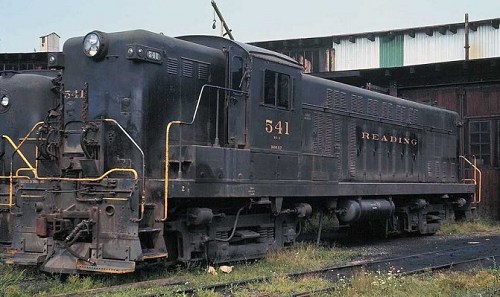 The Reading's AS-16s were usually seen operating alone in branchline service, or in pairs on Main Line and pusher service. The reason for this is that these locomotives could NOT operate in MU configuration with other makes of locomotives, such as the GP-7s and RS-3s due to differences in their control systems. This was clearly a factor that would limit their versatility in service on the Reading. In contrast with the reliability and utility of the many models of Baldwin switching locomotives owned by the railroad, the AS-16s had somewhat of a troubled history during their time in service. Within a year of their arrival, the AS-16s exhibited several mechanical problems which ultimately led to them being some of the first locomotives retired during the motive power upgrades of the 1960s. When the Reading placed an order for additional locomotives in 1953, they only ordered 4 additional AS-16s, while ordering considerably more EMD GP-7s and Alco RS-3s.
The Reading's AS-16s were usually seen operating alone in branchline service, or in pairs on Main Line and pusher service. The reason for this is that these locomotives could NOT operate in MU configuration with other makes of locomotives, such as the GP-7s and RS-3s due to differences in their control systems. This was clearly a factor that would limit their versatility in service on the Reading. In contrast with the reliability and utility of the many models of Baldwin switching locomotives owned by the railroad, the AS-16s had somewhat of a troubled history during their time in service. Within a year of their arrival, the AS-16s exhibited several mechanical problems which ultimately led to them being some of the first locomotives retired during the motive power upgrades of the 1960s. When the Reading placed an order for additional locomotives in 1953, they only ordered 4 additional AS-16s, while ordering considerably more EMD GP-7s and Alco RS-3s.
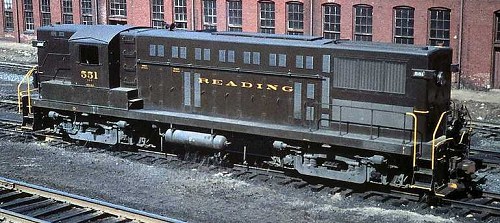 The last 4 AS-16s delivered to the Reading arrived in the second half of 1953 and were numbered 551-554. The most noticeable difference between these 4 locomotives and their earlier counterparts was that they used Baldwin's newer body style, with the long and short hoods the same height as the cab, somewhat resembling the style of an EMD GP-7. These locomotives also had a six-inch longer frame to accomodate some internal modifications. In an ironic turn of events, these locomotives COULD be operated in MU with the Reading's other locomotives, but could NOT be operated in MU with the road's other Baldwins!
The last 4 AS-16s delivered to the Reading arrived in the second half of 1953 and were numbered 551-554. The most noticeable difference between these 4 locomotives and their earlier counterparts was that they used Baldwin's newer body style, with the long and short hoods the same height as the cab, somewhat resembling the style of an EMD GP-7. These locomotives also had a six-inch longer frame to accomodate some internal modifications. In an ironic turn of events, these locomotives COULD be operated in MU with the Reading's other locomotives, but could NOT be operated in MU with the road's other Baldwins!
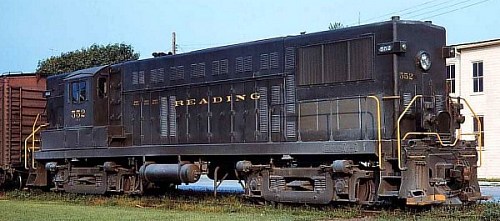 The Reading's AS-16s were used primarily in local or extra service, though they did see activity on through trains in the 1950s. In the late 50's, locomotives 576-589 were sent to the coal regions to work in mine and pusher service. As newer power came on-line in the 1960s, the Baldwins were demoted to yard and local freight service, with 576 through 589 remaining as pushers operating out of Gordon and Tamaqua. Baldwin ceased operations as a locomotive manufacturer in 1956. Coupled with their frequent mechanical problems, this was a principal factor in limiting the longevity of the Reading's AS-16s. By mid-1967, most of the Reading's AS-16s were off the roster. None of these locomotives were painted into any of the yellow-and-green or Reading green paint schemes. Most of the remaining AS-16s were traded to EMD in 1968 and 1969 as credit against the Reading's order for SW1500 switchers.
The Reading's AS-16s were used primarily in local or extra service, though they did see activity on through trains in the 1950s. In the late 50's, locomotives 576-589 were sent to the coal regions to work in mine and pusher service. As newer power came on-line in the 1960s, the Baldwins were demoted to yard and local freight service, with 576 through 589 remaining as pushers operating out of Gordon and Tamaqua. Baldwin ceased operations as a locomotive manufacturer in 1956. Coupled with their frequent mechanical problems, this was a principal factor in limiting the longevity of the Reading's AS-16s. By mid-1967, most of the Reading's AS-16s were off the roster. None of these locomotives were painted into any of the yellow-and-green or Reading green paint schemes. Most of the remaining AS-16s were traded to EMD in 1968 and 1969 as credit against the Reading's order for SW1500 switchers.
MODELING NOTES: As noted in the text, there were several "subclasses" of AS-16s on the Reading's roster, each with several different spotting features that must be considered when modeling these units. As can be seen in the photo at the top of the page, some units were equipped with a flashing strobe on the cab roof, which would be a unique feature on an operating model. Also, take note of the differences in handrails on the long hood between the earlier and later units, as well as the carbody height and the position of the numberboards as described in the text. Finally, from an operational standpoint, bear in mind how these units were used, and the fact that most of them could not MU with other Reading power.
Did You Know?
Downloads
 A variety of Reading Company operations related documents, etc. that may be of use in your modeling efforts.
A variety of Reading Company operations related documents, etc. that may be of use in your modeling efforts.
 A variety of Reading Company operations paperwork, such as train orders, clearance forms, etc. that will help you operate your Reading layout in a prototypical manner.
A variety of Reading Company operations paperwork, such as train orders, clearance forms, etc. that will help you operate your Reading layout in a prototypical manner.
 Public Timetables, Employe Timetables, and Rulebooks that provide much useful operational information.
Public Timetables, Employe Timetables, and Rulebooks that provide much useful operational information.
 Signs, billboards, and other FREE goodies for your use. We ask only that you help spread the word about The Reading Modeler!
Signs, billboards, and other FREE goodies for your use. We ask only that you help spread the word about The Reading Modeler!

